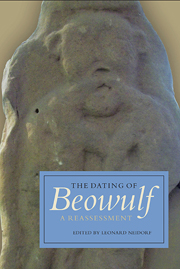Book contents
- Frontmatter
- Contents
- List of Tables
- List of Illustrations
- List of Contributors
- Acknowledgements
- Introduction
- 1 Beowulf and Language History
- 2 Germanic Legend, Scribal Errors, and Cultural Change
- 3 Names in Beowulf and Anglo-Saxon England
- 4 The Limits of Conservative Composition in Old English Poetry
- 5 The Date of Composition of Beowulf and the Evidence of Metrical Evolution
- 6 Beowulf and the Containment of Scyld in the West Saxon Royal Genealogy
- 7 History and Fiction in the Frisian Raid
- 8 ‘Give the People What They Want’: Historiography and Rhetorical History of the Dating of Beowulf Controversy
- 9 A Note on the Other Heorot
- 10 Beowulf and Conversion History
- 11 Material Monsters and Semantic Shifts
- 12 Scandals in Toronto: Kaluza's Law and Transliteration Errors
- 13 Afterword: Beowulf and Everything Else
- Index
11 - Material Monsters and Semantic Shifts
Published online by Cambridge University Press: 05 October 2014
- Frontmatter
- Contents
- List of Tables
- List of Illustrations
- List of Contributors
- Acknowledgements
- Introduction
- 1 Beowulf and Language History
- 2 Germanic Legend, Scribal Errors, and Cultural Change
- 3 Names in Beowulf and Anglo-Saxon England
- 4 The Limits of Conservative Composition in Old English Poetry
- 5 The Date of Composition of Beowulf and the Evidence of Metrical Evolution
- 6 Beowulf and the Containment of Scyld in the West Saxon Royal Genealogy
- 7 History and Fiction in the Frisian Raid
- 8 ‘Give the People What They Want’: Historiography and Rhetorical History of the Dating of Beowulf Controversy
- 9 A Note on the Other Heorot
- 10 Beowulf and Conversion History
- 11 Material Monsters and Semantic Shifts
- 12 Scandals in Toronto: Kaluza's Law and Transliteration Errors
- 13 Afterword: Beowulf and Everything Else
- Index
Summary
In Linguistic Means of Determining the Dates of Old English Literary Texts, Ashley Crandell Amos expressed doubt about the vast majority of proposed linguistic dating criteria. The book's pessimistic conclusions are generally not credible, since Amos evaluated criteria in terms of absolute certainty rather than relative probability; her positivistic disregard for probability resulted in negative conclusions that were both inevitable and meaningless. Yet for all that she unreasonably doubted, Amos took a more sanguine view of semantic evidence, affirming that semantic change could be instrumental “in providing evidence for the date of composition of various Old English texts.” Many native Old English words gradually changed their meanings after the advent of Christianity, losing older connotations and assuming new ones in order to adapt to novel concepts and ideas. The semantic history of Old English words originally referring to monsters of Germanic folklore, in particular, may shed light upon the dating of Beowulf. Over time, some of these words lost their ability to refer to a wider range of (physical) monsters and began exclusively to mean (spiritual) “demon” or “devil.” It is clear that some of these words cannot have had such a narrow range of meaning in Beowulf, however, where they are uttered by pagan characters ignorant of the Christian revelation and never by the poem's scripturizing narrator. In this essay, I first argue that two words – scucca and þyrs – possess only their pre-conversion meanings in Beowulf, for if they had acquired a Christian meaning by the time of composition, the poet would have violated his own design.
- Type
- Chapter
- Information
- The Dating of BeowulfA Reassessment, pp. 202 - 218Publisher: Boydell & BrewerPrint publication year: 2014

